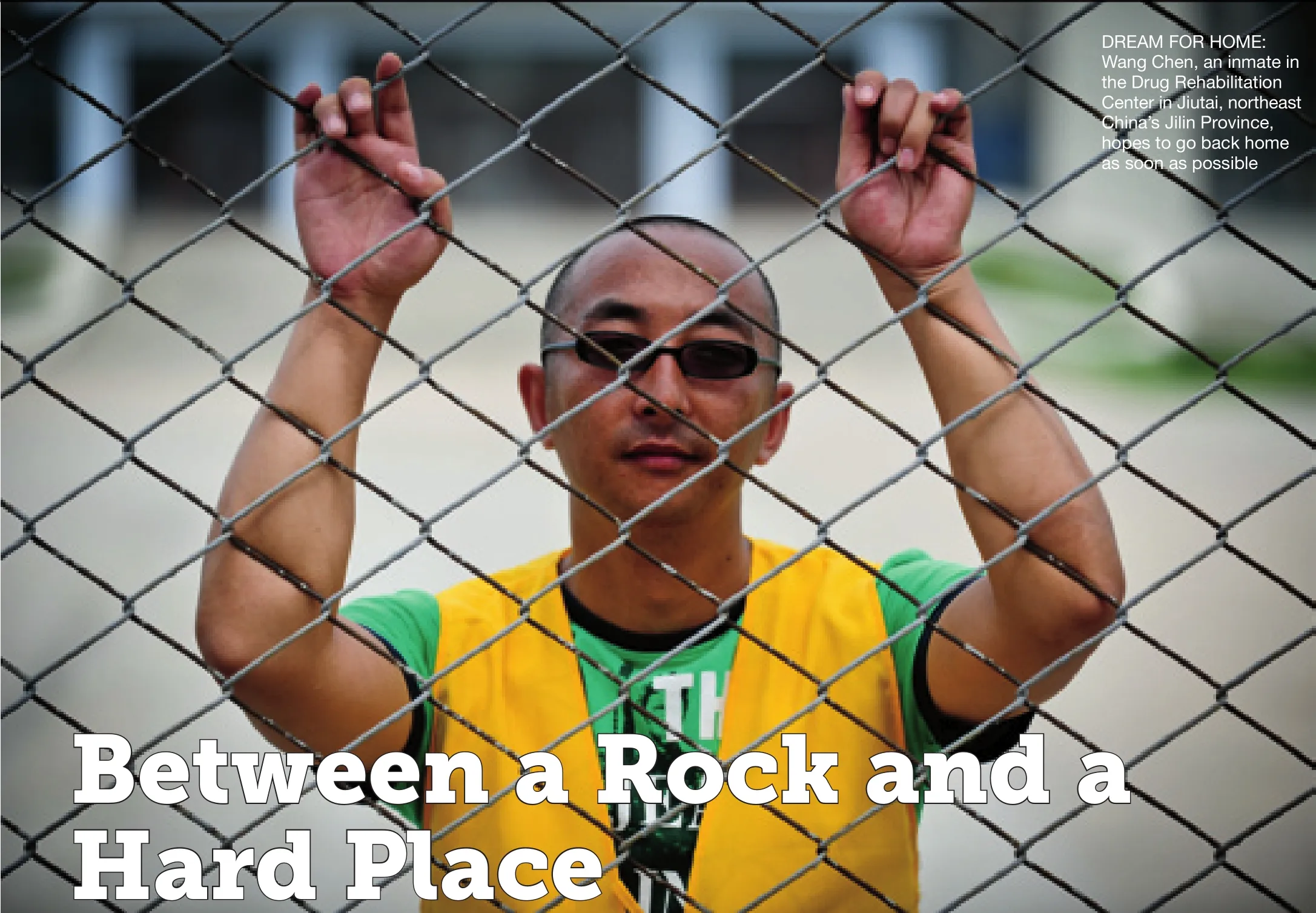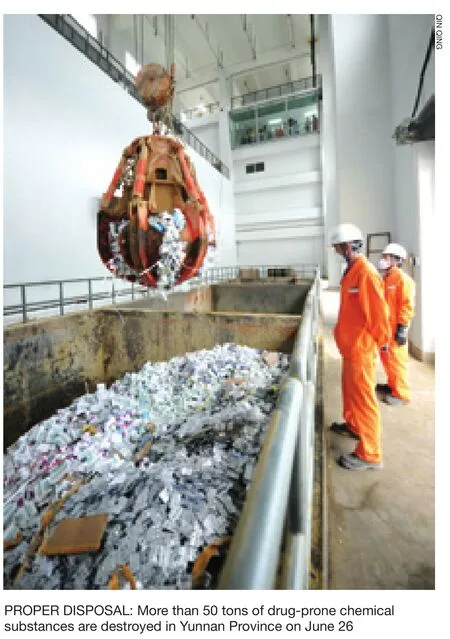BETWEEN A ROCK AND A HARD PLACE
China faces challenges in fighting against drug abuse and illicit trafficking By Yuan Yuan
BETWEEN A ROCK AND A HARD PLACE
China faces challenges in fighting against drug abuse and illicit trafficking By Yuan Yuan

XU CHANG
W ang Chen’s dream is to return home after eventually being released from the Drug Rehabilitation Center in Jiutai City, northeast China’s Jilin Province.
Wang, 36, had been taking drugs since he sustained business losses in 2005.
“At first I just wanted to give it a try as it helped to relieve heavy stress, but soon I got addicted and could not get rid of it at all,”said Wang, who then gave up his business and put all the money into purchasing drugs.
“In those days, I spent all the time either taking drugs or sleeping,” Wang said. “I felt dizzy every day and didn’t have the energy to do anything else.”
In August 2011, Wang was arrested for possession of narcotics and sent to a drug rehabilitation center. “My wife didn’t know about me taking drugs as I always deceived her,” Wang said. “She was astonished to know the truth but finally forgave me. Now I really want to go back home and start life over again.”
In the rehabilitation center, Wang wrote an article,Dream and Heaven. “I thought I could go to heaven by taking drugs, but I ended up staying in the walls. Every morning, I looked through the windows to the direction of my hometown. The walls locked my dreams,” it said.
On June 25, one day before International Day Against Drug Abuse and Illicit Trafficking, Wang expressed his strong will to quit drugs and go back home during an interview with Xinhua News Agency.
Media outlets tell many stories about drug abuse around the special day. Xiaoqin, 33 years old, who refused to reveal her real name, started taking drugs in 1999 when she was a middle school student. “I was just a teenager and thought it is very cool to take drugs,” said Xiaoqin onLet Me Help You, a TV program in Chongqing in southwest China.
But this “cool” habit cost her dearly. Xiaoqin stole money from her parents and spent every penny on drugs. “At first I only needed 20 yuan ($3.15) or 30 yuan ($4.72) every day, and finally I needed more than 400 yuan ($62.95) each day,” said Xiaoqin, who was sent to rehabilitation centers quite a few times but relapsed each time.
“My parents finally gave up on me. My personal life was a mess as well until 2008, when I gave birth to my daughter,” she said. “It was my daughter who made me decide firmly that I had to quit drugs completely.”
Statistics from the Ministry of Public Security show that at the end of 2011, there were more than 1.79 million registered drug abusers in China, while in 2008, the number was only 860,000.
“The number of crimes concerning drug trafficking and abuse has increased dramatically in recent years as well as the number of drug abusers,” said Liu Yuejin, Director of Narcotics Control Bureau of the Ministry of Public Security.
According to Liu, in 2011, 4.18 tons of illegal drugs were seized in Xishuangbanna Dai Autonomous Prefecture in southwestern Yunnan Province alone, more than the previous six years combined. Xishuangbanna lies along the China-Myanmar border.
A Bitter Battle
China is fighting an uphill battle against drug trafficking and abuse amid a rebound in opium production in neighboring countries and the rise of domestic production of synthetic drugs.
Two important sources of China’s drug imports are the Golden Triangle, the world’s major opium-producing area that overlaps the mountains of Myanmar, Viet Nam, Laos and Thailand, and the Golden Crescent, which encompasses the mountain valleys of Iran, Afghanistan and Pakistan.
“Chinese regions adjacent to the Golden Triangle and the Golden Crescent—Yunnan and Guangxi Zhuang Autonomous Region in the south, and Xinjiang Uygur Autonomous Region in the northwest—have been hit worst,” said Li Wenjun, a professor specializing in drug control at the Chinese People’s Public Security University in Beijing.“In addition, inflow of cocaine from South America is increasing and domestic drug production is also expanding.”
Figures from China’s Ministry of Public Security show the poppy growing area in north Myanmar has increased to 44,867 hectares this year, up 41 percent year on year.
Meanwhile, the cultivation of the poppy crop in Afghanistan reached 131,000 hectares in 2011, a year-onyear increase of 7 percent, according to an annual opium survey conducted by the UN Office on Drugs and Crime.
Drug control departments in Xinjiang last year cracked 10 major smuggling cases involving drugs from Afghanistan. The amount of seized heroin was about 20 times more than that of 2010, according to the police.
China had been basically free from drug perils for three decades since the founding of the People’s Republic of China in 1949. In the late 1970s, Yunnan became the country’s first area hit by the illicit use of drugs. The province has a 1,997-km-long land border with Myanmar and a 710-km border with Laos.
According to the China Drug Control Report of 2011, over half of China’s narcotics imports were from the Golden Triangle area. In the early 1980s, drugs started to flow from Myanmar and Laos into Yunnan, which were then trafficked eastward to coastal Guangdong Province in the south and even further to Hong Kong and Macao.
“As Yunnan was on the drug trafficking route, some local people were enticed to use drugs and a local market gradually took shape,” Chen Cunyi, Deputy Director of Narcotics Control Bureau of the Ministry of Public Security, toldSouthern Weekly, a newspaper published in Guangzhou, capital of Guangdong.
Responses
The Chinese Government responded to the growing illicit drug problem by intensifying punishments for drug-related crimes and setting up special anti-drug squads. In 1982 serious drug trafficking was made a capital offence. The same year, a 1,000-strong antinarcotics force, the first of its kind in the country, was formed in Yunnan. This year marks the 30th anniversary of its founding.
Professor Liu at the Chinese People’s Public Security University revealed that police authorities nationwide uncovered 529 cases involving drug manufacturing in China last year, an increase of 20 percent over 2010.
Some people also set up organizations on their own initiative to help drug addicts to kick the habit.
Meng Fanying, a 54-year-old anti-drug activist from Changsha, capital of central Hunan Province, set up the city’s first nongovernmental anti-drug education center for juveniles in 2008, which has offered help to more than 1,000 young people. As a veteran volunteer, she has also given nearly 100 lectures and presented books to many who are struggling to end their drug addictions, winning herself the nickname Anti-Drug Mom.
“The popularity of the Internet has made it easier for criminals to contact each other,” said Liu. “Also, methods of producing drugs are evolving all the time, which makes crackdowns more difficult. Therefore more campaigns against drug production in China will be launched and closer international cooperation in drug control is necessary.”
In November 2011, China, Laos, Myanmar and Thailand agreed to boost law enforcement and jointly conduct security operations along the Mekong River to combat drug and human trafficking.
Meanwhile, China has established a case-by-case cooperation mechanism with its three neighbors. Four police liaison offices have also been set up in border areas to facilitate investigations.
Under the agreement between China and Myanmar, police authorities in both countries have arrested and repatriated about 60 fugitives since 2009, including drug lords, according to figures from the Chinese police.


